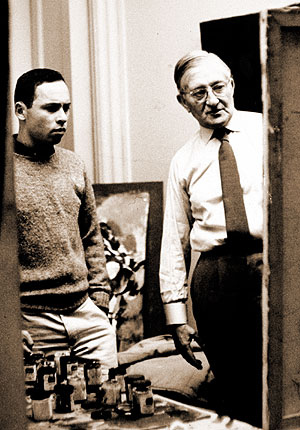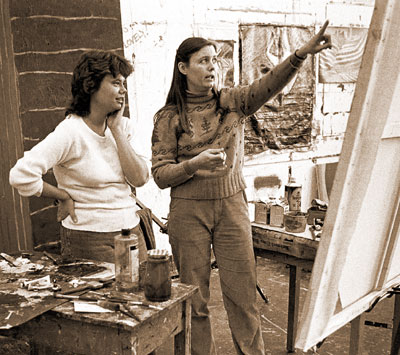Discerning
Voices
It was Karl Marx, I think,
who once proposed that evolution be studied in reverse,
with an eye firmly fixed on the evolved species while glancing
backward for hints.
—Jerome Bruner, In Search of Mind
Two
high school teachers changed my life—altered forever
the way I saw the world and the way I lived my life. Mr. Walsh
taught me, in eleventh grade English class, that art has meaning
beyond its surface: that music is more than just tunes, that
literature is more than just stories, that painting is more than
just pictures.
Mr. Worful taught me, in twelfth grade Humanities class, that
art has context: that the art of ancient Greece reflects the
classical
values of its time; that the democratic revolutions of the 18th
century helped spawn Romanticism; that the collapse of faith
in universal values in the 20th century helped to shape modernism.
Mr. Walsh introduced me to interpretation; Mr. Worful, to the
zeitgeist.
Together they taught me that the best art is dense, multi-layered,
part of its time and place, and part of an ongoing story.
Today I too easily forget that I once knew none of this. What
my teachers taught me formed the foundation from which my understanding
and appreciation of art, music, and literature were built, and
that foundation is deeply ingrained in my consciousness.
But it
had to be learned.
|
|
 |
|
Victor Kord with Josef Albers at Yale
University in 1959.
 |
Pivot Points is
a show about teachers, mentors, and students. Each painting in
the exhibit is the unique work of
an individual painter, but is also part of an ongoing story of
teachers teaching students and students teaching teachers. The
exhibit brings together three generations of artists: Victor Kord
and Richard Lazzaro, who taught and mentored Sally Bowring and
Reni Gower; and Valerie Bogdan and Beth Weisgerber, who were taught
and mentored by Bowring and Gower. Each of these artists developed
and honed their craft under the watchful, nurturing eyes of teachers
and mentors—and then did the same for the generation that
followed them. In Pivot Points, their work is seen
together, in one place, for the first time.
If teachers introduce students to a field
or discipline by imparting knowledge and skills, mentors take
this a step further—prized
for their wisdom and experience, they become trusted counselors.
The word
"mentor" originates in the Odyssey, where
Mentor is a trusted advisor to Odysseus, the king of Ithaca. When
Odysseus leaves for the Trojan War, he places Mentor in charge
of his household and instructs him to look after his son, Telemachus.
When the war ends and Odysseus doesn’t return with the other
men, Telemachus—now a young man—is grief-stricken.
Opportunists try to seduce his mother and pillage the family estate,
but Telemachus does nothing. At this critical moment, the goddess
Athena impersonates Mentor and coaxes Telemachus out of passivity.
He leaps into action—taking control of his father’s
household, and mounting an expedition to search for the king.
A mentor, then, is a kind of surrogate
parent—part guide,
part tutor, part role model—tasked with nurturing his or
her charge into moral and emotional maturity. That Athena—goddess
of war and wisdom—sometimes impersonates this figure implies
that mentorship is partly divine, or involves the distribution
of something divine. Or perhaps the goal of our mentors is to reveal
the divine within us: to cause our daimon—that image of
our ideal self that Plato said dwells in each of us—to
emerge and guide us towards our calling in life.
If so, the true goal of artistic mentorship
is simply for older artists to help younger artists find and
develop their own voice.
This is a process that is most possible today in universities—where
artist-professors can still serve as guides, tutors, and role models,
unburdened by the deadline pressure and ego-management of the super-famous.
Hence, Pivot Points.
|
|
 |
|
Student Tamara Lettie with Reni Gower at
Virginia Commonwealth University in 1982.

|
The artists in Pivot
Points are
abstract painters who use non-representational visual language
to explore the elusive
and ephemeral nature of moods, intuition, and non-verbal ideas.
Their paintings are contemporary, but pedigrees are discernable
appropriate to each artist’s era of education. So the work
of Kord and Lazzaro—mythic, humorous, and meditative—is
rooted in the visionary non-objectivism of post-war abstraction,
while the work of Gower and Bowring—intensely colorful,
geometrically structured, alluding to textiles—draws on
a formal vocabulary from the era of colorfield, decoration, and
pattern painting. Finally, the work of Bogdan and Weisgerber— formally
loose but emotionally tense, with rich visual associations and
a ghost of narrative just below the surface—reflects the
dizzying array of styles characteristic of their own Painting Is/Isn’t
Dead era of postmodern accumulation.
So, is there a clear kinship between
these artists? Yes. The attentive viewer will spot influences,
harmonies, and aesthetic alliances
that exist two generations apart. But in these subtle and very
sophisticated paintings they are difficult to describe in words.
Like an encounter between relatives or a comparison of old family
photographs the heredity is apparent—one could almost imagine
that this exhibit was a retrospective tracing a single artist’s
work from post-war maturity to postmodern old age—but it’s
easier to read with one’s eyes than to articulate in plain
speech. That’s as it should be; these are, after all, abstract
paintings. At a general level, their most striking qualities are
their vibrant color, their sophisticated design, and their refined
use of materials. Delicate and bright, balanced but bold, in the
genealogy of modern art these paintings descend less from Picasso
than from Matisse. They burst with personality and radiate a sense
of joy, or at least peace, found in the pursuit of painting.
Twenty years ago, two high school teachers
changed my life. Since then, predictably, various other teachers
have challenged everything
they taught me. They told me that Mr. Walsh got it all wrong: that
art itself has no meaning beyond what we invest in it, that this
meaning is relative and mutable, that art isn’t so much a
thing as it is a way of looking at things. They told me that Mr.
Worful was wrong as well: that context is illusory—just
one in an endless series of "frames" we create to view
and describe "texts" that are essentially meaningless.
But I’m not in high school anymore. I
teach art history myself now, and I remain unconvinced that the
building blocks of
context and interpretation form a faulty foundation for a critical-historical
understanding of art. I also care less and less. What matters most
is the work, not the talk, and in Pivot Points—a
celebration of pure painting and the interactions of teachers and
students—the work, thankfully, does all the talking. 
Steven L. Jones is an artist, teacher, and writer who lives in
Richmond, Virginia.
The
Painters:
Introduction |
|
Discerning
Voices |
|
The
Poets:
Introduction
|
|
Talking
with
Both Hands |
 |
 |
 |
 |
 |
 |
 |
| Richard
Roth |
|
Steven
L. Jones |
|
Mary Flinn |
|
J. Randy
Marshall |

|